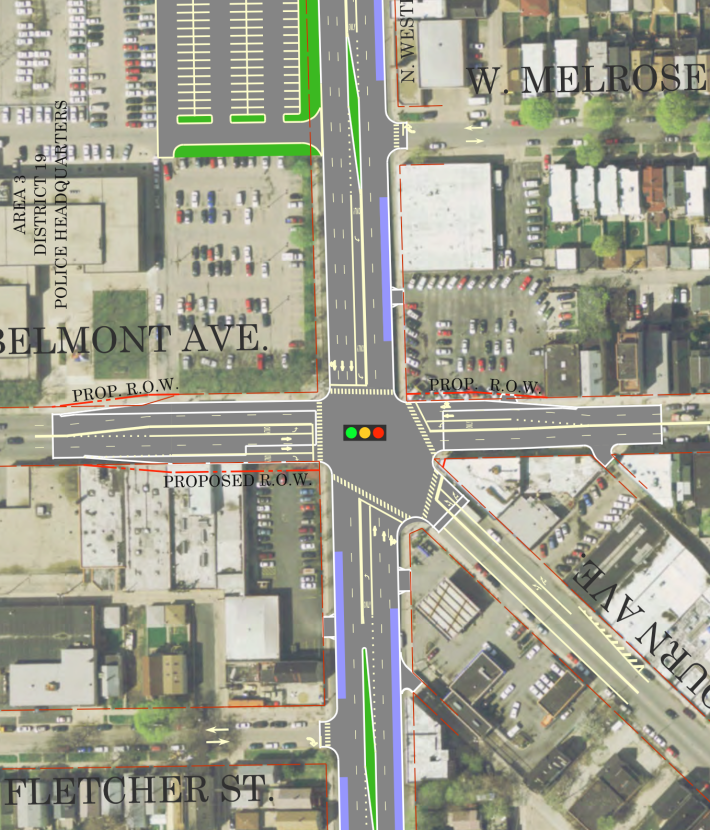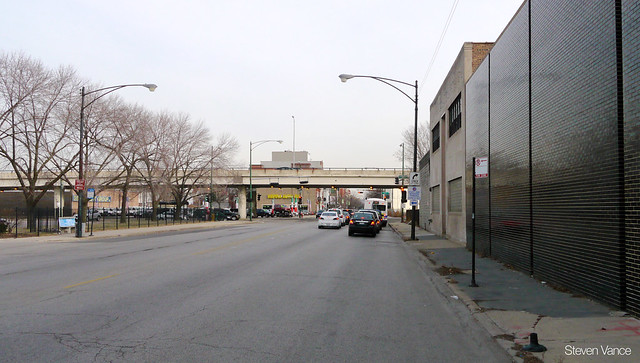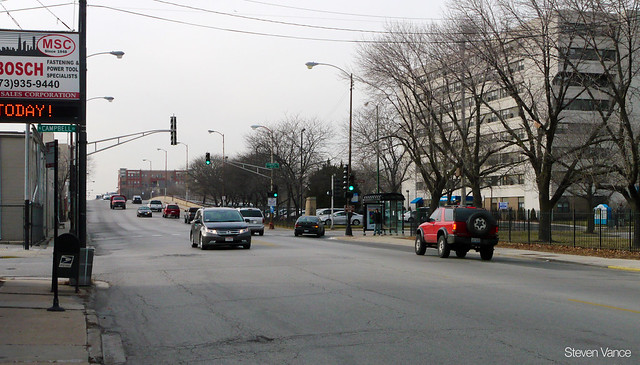
Bicycling up and over the Chicago River on Belmont, from Avondale to Roscoe Village, will soon be more comfortable once the Chicago Department of Transportation gives the street a "road diet" and replaces car travel lanes with new buffered bike lanes. Bicyclists shouldn't get too comfortable, though: Once they've crested the bridge eastbound, they'll be dropped into the middle of a six-lane highway. Yes, CDOT is narrowing Belmont from four lanes to two on one block, and then on the very next block widening Belmont to six lanes, while eliminating the bike lanes completely.
The road diet is planned between Western Avenue (2400 West) and Washtenaw Avenue (2700 West). Its buffered bike lanes will extend west to Kedzie Avenue and, eventually, east to Halsted Street in Lakeview. Not only will the road diet give bicyclists a rare chance to safely climb over the Chicago River, but it will bring Belmont into a consistent lane configuration -- it's two lanes wide both east of Western and west of Washtenaw. Two lanes is perfectly appropriate for Belmont's light traffic: 14,000 cars per day were counted in 2010, which two lanes easily handle on similar streets like Milwaukee Avenue and Halsted.
Yet, at the exact same time, CDOT is continuing to advance another plan for Belmont that's at odds with the goal of making it a comfortable street for bicycling and walking. As Belmont approaches Western, where a crumbling overpass is being removed, the street will balloon from two to six lanes wide. The planned intersection [PDF] will require condemning private property, demolishing the fronts of several buildings at the southwest corner, and halt the bike lanes hundreds of feet short of the intersection.
This widening project is eerily reminiscent of how Harrison Street was widened at Congress Parkway, an unsafe and unnecessary move that was finally undone last year. The situation didn't improve traffic flow much, since it simply created bottlenecks on either side where several lanes had to merge into one. The widening is also at odds with CDOT's current practice of striping bike lanes through intersections, and puts bicyclists at greatest risk right where they most need protection.

Belmont is designated as a key Crosstown Bike Route in the city's Streets for Cycling Plan 2020, and would be a great way for bicyclists to get between the north and northwest sides if only there weren't a huge, crowded, high-speed intersection dropped right into the middle of it. Michelle Stenzel was a co-leader for the plan's North Side district, co-chairs Bike Walk Lincoln Park, and is disappointed with CDOT's plans for Belmont at Western.
A wider Belmont "will never, ever attract new bike riders, when people are left with completely no help, no protection, and no direction at a huge intersection like this," Stenzel says. "It was supposed to serve as an important east-west route," she said, but will prove too dangerous for many potential bicyclists. Stenzel took umbrage with using city funds to buy buildings and widen the road: "It's infuriating" that, while "city planners have a blank slate [because of the flyover teardown]... there's not a single inch of room to provide bicyclists a safe passage."
After these concerns were brought up to Aldermen Deb Mell and Scott Waguespack, CDOT project manager Charlene Walsh said the project respects the city's complete streets policy and considers vulnerable road users, children and seniors.
Walsh said that "[complete streets] concepts are being implemented in the project where feasible" -- even though, as Stenzel points out, the city's definition of "feasible" doesn't include bike safety. She added that the Safe Routes to School Program at nearby Lane Tech High School would continue, and CDOT would build pedestrian islands at nearby intersections.
However, bike facilities were explicitly excluded from this project, since "Western is the dominant street when considering design requirements, and the narrowing (reduction) of Belmont [travel lanes] cannot occur," Walsh said. In other words, since Belmont has four lanes today, it must always continue with at least four through lanes, plus new turn lanes to let cars roll through even faster.
Updated to remove a statement saying there would be a bulbout on Clybourn.





